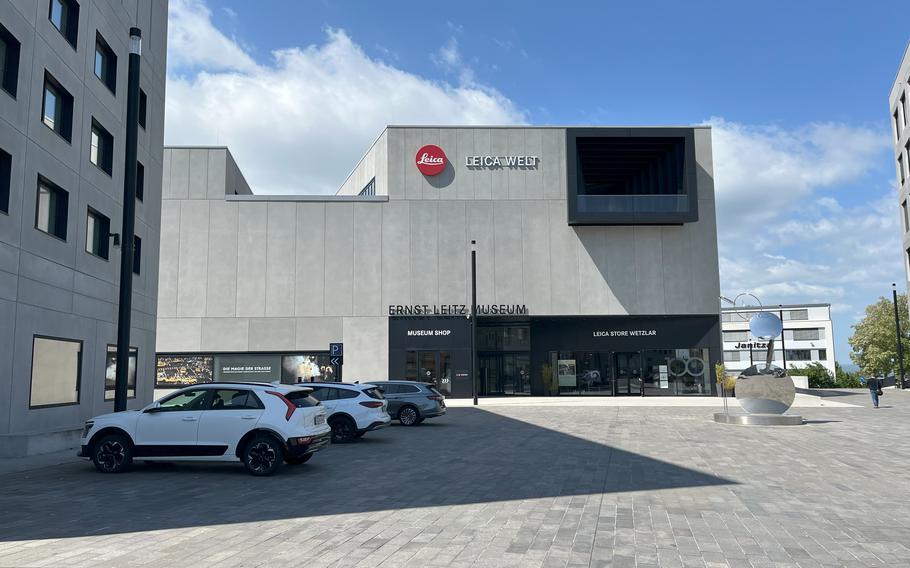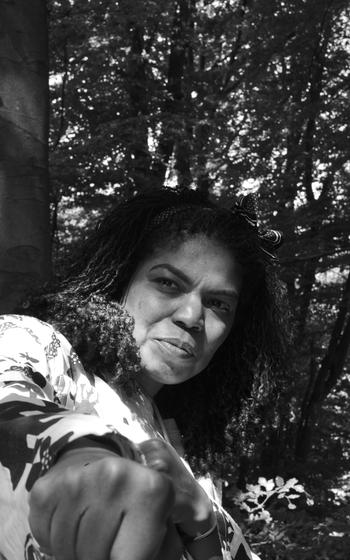
The exterior of the Leica World complex in Wetzlar, Germany, showing the building housing the Ernst Leitz Museum. The balcony is shaped like a camera viewfinder. (Chrissy Yates/Stars and Stripes)
As I drove up to the Ernst Leitz Museum, my shutterbug friend pointed up at the building and said, “Oh, it’s shaped like a camera! Look, that’s the viewfinder!”
As I rounded the building to park, she added, “And that’s the lens!” I smugly knew that my choice of Wetzlar, the birthplace of the famous Leica handcrafted camera, was the perfect tour stop for her first trip to Germany.
This year marks the 100th anniversary of the debut of the Leica I, the first mass-produced 35 mm camera. Centenary events are being held worldwide from Milan to Tokyo to Dubai.
The museum, about an hour’s drive north of Frankfurt, is part of the Leica World at Leitz Park industrial park, which includes the company headquarters, the Ernst Leitz Hotel, Cafe Leitz, a nature trail and more.
While planning our trip, I decided we needed a more curated museum experience than the regular entry fee of 11 euros provides.
For 149 euros, we did the “Max: A Day at Leica World” experience. That eye-watering price included a VIP tour for two in English, a reservation for coffee and cake at Cafe Leitz and — most importantly — a Leica camera rental of our choice.
After handing each of us a red-dot Leica pin, our guide explained that Leica is a portmanteau of company founder Leitz’s name and the word “camera.” Then we crossed the street to the production and administration building, which is shaped like a roll of film.
This side of the complex includes the Leica Galerie Wetzlar. While interesting, that side of the Leitz Park is more for Leica enthusiasts, people who wouldn’t mind spending several months of mortgage payments on a camera.
I found what was inside the museum far more accessible. While the ground floor is dedicated to a large exhibition of award-winning photography — at the time of our visit, it was street photography — it gets more fun and interactive upstairs.
First, though, you need to download the Leica app. There you can learn more about the industrial park, but most importantly create and access your personal image gallery.
Then a series of glass placards teaches photography basics such as the golden ratio, rule of thirds, focal length, exposure and more, a perfect primer for me as a journalist. It turns out the camera lens we saw from the parking lot has an aperture that slowly opens and closes.
Our guide walked us through the various Leica photo stations. They were self-explanatory, with instructions that toggled easily between German and English. Then we rushed to end the tour so we could make our reserved time slot at the cafe.
After our refreshments, it was finally time to visit the Leica store for our rental. My friend really wanted to try her hand at black-and-white photography, so we picked up the M-11 Monochrom.
The sales staff was great and showed how to use the rangefinder to manually focus. I was a bit annoyed that we were asked if we’d brought an SD card, as apparently that was the only way to take our photos home. Luckily, I had one in my hobbyist camera.
At the salesperson’s suggestion we headed to the nature trail. There, we attempted to re-create Thomas Hoepker’s 1966 photo of Muhammad Ali punching toward the camera. It’s part of the “36 Aus 100” permanent exhibition in the Leica Galerie Wetzlar.
The exhibition consists of a selection of 36 photos from the past 100 years that the company says “have made photographic history and helped establish the myth of the Leica brand.”
Despite being a southpaw, I took a few right jabs at the camera. But I think you can see the fear in my eyes of getting too close to something that retails for more than $10,000.

Chrissy Yates reenacts Thomas Hoepker’s famous 1966 photo of Muhammad Ali punching at the camera during a May visit to the Ernst Leitz Museum in Wetzlar, Germany. (Elizabeth Enockson/Special to Stars and Stripes)
Then we switched sides and I took blurry photos of her as I struggled to line up the image in the rangefinder. Sadly, my best shots were of my feet and a stack of logs. But in spite of the results, I still had a lot of fun in the attempt.
After returning the camera, we revisited the museum’s various photo stations to create self-portraits. My favorite station was a photo booth-style room with a one-way mirror and a camera behind it surrounded by lights.
Museum visitors sit at the bench and use a panel of switches on the side to play with the brightness, direction, amount and source of the light.
Yet another room lets visitors turn on giant fans and adjust the airflow speed and direction to get a perfect windblown look for an Instagram profile.
There is also a “digital darkroom” where visitors can take one of the photos from their gallery and go through the steps of analog film development.
A QR code at each station transfers images to the Leica app, and visitors have 14 days to download them before they’re deleted from the virtual gallery.
No modern museum experience is complete without a visit to the gift shop, which you must enter to print out your free photo souvenir.
The shop offers books on photography, posters of Leica cameras and my favorite memento, a 3D-puzzle Leica I. At 80 euros, it’s the only Leica I’ll be able to afford — for now.
Leica World — Leica HQ and Ernst Leitz Museum
Address: Am Leitz-Park 6, Wetzlar, Germany
Cost: HQ entry is free; museum entry is 11 euros for adults, free for children 8 and younger, 24 euros for families.
Hours: Daily, 10 a.m.-6 p.m.; Cafe Leitz, Tuesday-Sunday, 11:30 a.m.-5:30 p.m.; canteen, Monday-Friday, 7:30 a.m.-10 a.m. and 11:45 a.m.-1:30 p.m.
Information: leicawelt.com/en